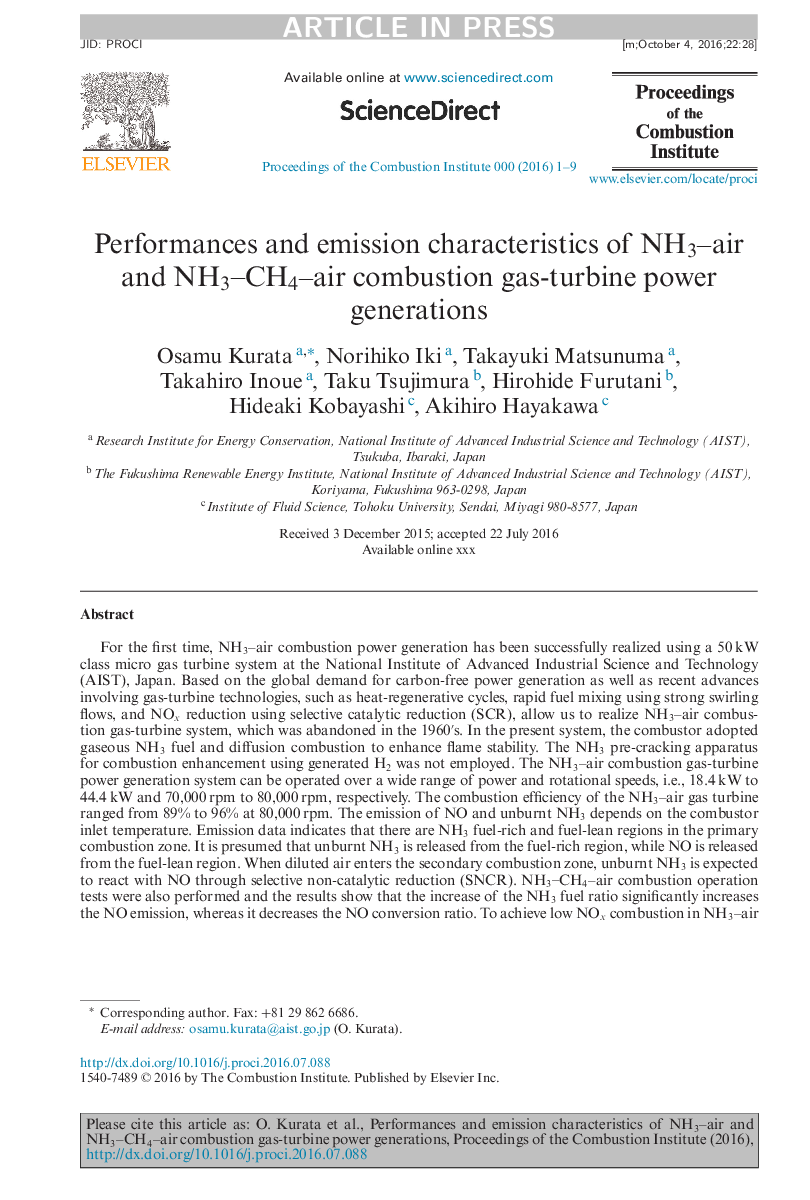| کد مقاله | کد نشریه | سال انتشار | مقاله انگلیسی | نسخه تمام متن |
|---|---|---|---|---|
| 4915389 | 1427915 | 2017 | 9 صفحه PDF | دانلود رایگان |
عنوان انگلیسی مقاله ISI
Performances and emission characteristics of NH3-air and NH3CH4-air combustion gas-turbine power generations
دانلود مقاله + سفارش ترجمه
دانلود مقاله ISI انگلیسی
رایگان برای ایرانیان
موضوعات مرتبط
مهندسی و علوم پایه
مهندسی شیمی
مهندسی شیمی (عمومی)
پیش نمایش صفحه اول مقاله

چکیده انگلیسی
For the first time, NH3-air combustion power generation has been successfully realized using a 50Â kW class micro gas turbine system at the National Institute of Advanced Industrial Science and Technology (AIST), Japan. Based on the global demand for carbon-free power generation as well as recent advances involving gas-turbine technologies, such as heat-regenerative cycles, rapid fuel mixing using strong swirling flows, and NOx reduction using selective catalytic reduction (SCR), allow us to realize NH3-air combustion gas-turbine system, which was abandoned in the 1960â²s. In the present system, the combustor adopted gaseous NH3 fuel and diffusion combustion to enhance flame stability. The NH3 pre-cracking apparatus for combustion enhancement using generated H2 was not employed. The NH3-air combustion gas-turbine power generation system can be operated over a wide range of power and rotational speeds, i.e., 18.4Â kW to 44.4Â kW and 70,000Â rpm to 80,000Â rpm, respectively. The combustion efficiency of the NH3-air gas turbine ranged from 89% to 96% at 80,000Â rpm. The emission of NO and unburnt NH3 depends on the combustor inlet temperature. Emission data indicates that there are NH3 fuel-rich and fuel-lean regions in the primary combustion zone. It is presumed that unburnt NH3 is released from the fuel-rich region, while NO is released from the fuel-lean region. When diluted air enters the secondary combustion zone, unburnt NH3 is expected to react with NO through selective non-catalytic reduction (SNCR). NH3CH4-air combustion operation tests were also performed and the results show that the increase of the NH3 fuel ratio significantly increases the NO emission, whereas it decreases the NO conversion ratio. To achieve low NOx combustion in NH3-air combustion gas turbines, it is suggested to burn large quantities of NH3 fuel and produce both rich and lean fuel mixtures in the primary combustion zone.
ناشر
Database: Elsevier - ScienceDirect (ساینس دایرکت)
Journal: Proceedings of the Combustion Institute - Volume 36, Issue 3, 2017, Pages 3351-3359
Journal: Proceedings of the Combustion Institute - Volume 36, Issue 3, 2017, Pages 3351-3359
نویسندگان
Osamu Kurata, Norihiko Iki, Takayuki Matsunuma, Takahiro Inoue, Taku Tsujimura, Hirohide Furutani, Hideaki Kobayashi, Akihiro Hayakawa,